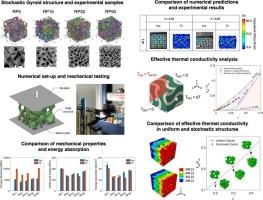Mechanical and thermal responses of random triply periodic minimal surface structures
IF 7.9
2区 材料科学
Q1 MATERIALS SCIENCE, MULTIDISCIPLINARY
引用次数: 0
Abstract
This study investigates the mechanical and thermal responses of stochastic Triply Periodic Minimal Surface (TPMS) structures fabricated using the laser powder bed fusion process with Ti-6Al-4V. Stochastic Gyroid structures were generated by introducing Voronoi-based randomness, allowing for controlled variations in stochasticity. Mechanical behavior was evaluated through finite element (FE) simulations with damage modeling and compressive testing, while thermal performance was analyzed using steady-state finite element modeling with periodic boundary conditions. Experimental and FE results demonstrated that increasing stochasticity alters failure mechanisms by dispersing deformation across sub-domains, reducing macroscopic shear band formation. Among stochastic structures, greater randomness from 5 to 50 random points led to an increase in elastic modulus, initial peak stress, and energy absorption by 38 %, 27 %, and 54 %, respectively. Additionally, while uniform TPMS structures exhibited higher effective thermal conductivity, aligning with the upper limit of Maxwell-Eucken’s models, stochasticity reduced effective thermal conductivity by approximately 8–16 %. Overall, although uniform Gyroid structures exhibited superior mechanical and thermal performance across all evaluated properties, these findings provide new insights into the trade-offs between mechanical resilience and thermal transport in stochastic TPMS architectures, highlighting their potential for multi-functional applications in automotive components, aerospace structures, and structural energy storage systems.

随机三周期最小表面结构的力学和热响应
本文研究了Ti-6Al-4V激光粉末床熔合工艺制备的随机三周期最小表面(TPMS)结构的力学和热响应。随机陀螺结构是通过引入基于voronoi的随机性生成的,允许随机性的可控变化。通过损伤建模和压缩测试的有限元模拟来评估其力学性能,而采用周期性边界条件的稳态有限元模拟来分析其热性能。实验和有限元分析结果表明,增加随机度可以通过分散变形在子域上改变破坏机制,减少宏观剪切带的形成。在随机结构中,从5到50个随机点的较大随机性导致弹性模量、初始峰值应力和能量吸收分别增加38%、27%和54%。此外,虽然均匀TPMS结构具有较高的有效导热系数,符合Maxwell-Eucken模型的上限,但随机性使有效导热系数降低了约8 - 16%。总的来说,尽管均匀的Gyroid结构在所有评估的性能中都表现出优越的机械和热性能,但这些发现为随机TPMS结构中机械弹性和热传输之间的权衡提供了新的见解,突出了它们在汽车零部件、航空航天结构和结构储能系统中的多功能应用潜力。
本文章由计算机程序翻译,如有差异,请以英文原文为准。
求助全文
约1分钟内获得全文
求助全文
来源期刊

Materials & Design
Engineering-Mechanical Engineering
CiteScore
14.30
自引率
7.10%
发文量
1028
审稿时长
85 days
期刊介绍:
Materials and Design is a multi-disciplinary journal that publishes original research reports, review articles, and express communications. The journal focuses on studying the structure and properties of inorganic and organic materials, advancements in synthesis, processing, characterization, and testing, the design of materials and engineering systems, and their applications in technology. It aims to bring together various aspects of materials science, engineering, physics, and chemistry.
The journal explores themes ranging from materials to design and aims to reveal the connections between natural and artificial materials, as well as experiment and modeling. Manuscripts submitted to Materials and Design should contain elements of discovery and surprise, as they often contribute new insights into the architecture and function of matter.
 求助内容:
求助内容: 应助结果提醒方式:
应助结果提醒方式:


